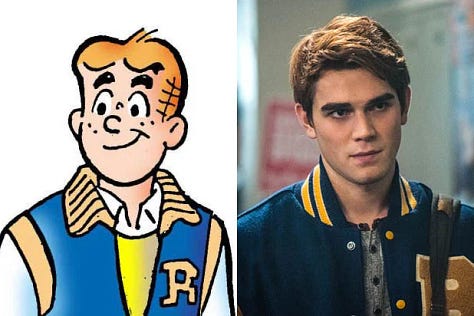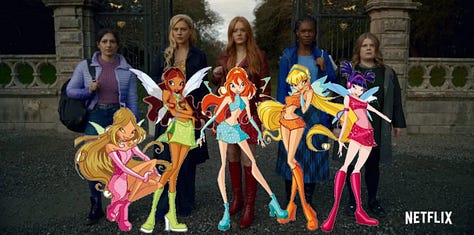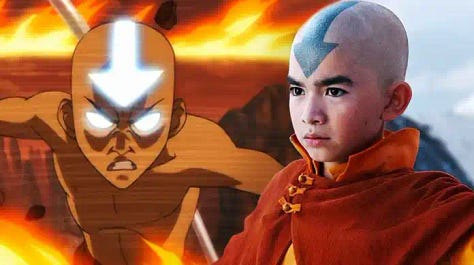


I’m a really nostalgic person. I love reminiscing about the past, sometimes in the most random ways. The other day, I had the sudden urge to make a Letterboxd list of the Japanese shōjo films I watched when I was in highschool—back when liking Japanese culture wasn’t an … aesthetic (?).
Most of them were from the 2000s and 2010s, and as I scrolled through my selections, I noticed something interesting: nearly all of them were live-action adaptations.
Which got me thinking.
The trend of adapting anime and manga into films and dramas isn’t new—Japan has been doing it for decades. Some adaptations, like Erased or Life, have actually been pretty great.
But when I started comparing Japanese live-action adaptations to Western adaptations of cartoons and comics, something became clear:
Hollywood is really failing at adapting nostalgic childhood content.
I’m not talking about Marvel, DC, or the endless superhero films. I mean the adaptations of the shows and movies we grew up with. It’s like there is a need to capitalize on nostalgia but it ends up making us question why we ever liked the original in the first place.
Think of Winx Club, Riverdale, The Last Airbender. What should’ve been an easy win with built-in fan bases somehow became disasters. But why?
With more reboots on the horizon (Harry Potter TV series, Pride and Prejudice again?), I wanted to figure out where these adaptations keep going wrong. And I have a theory:
It all boils down to misunderstanding nostalgia.
What is nostalgia, really?
Before we dive into the failures, we need to understand nostalgia itself.
David Berry, in his book On Nostalgia, defines it as:
… a fundamentally impossible yearning, a longing to go back even we were driven ceaselessly forward, pushed further away from our desire even as we sit contemplating it.
Berry, David. On nostalgia. Coach House Books, 2020.
Nostalgia isn’t about accuracy—it’s about emotion. It’s a filtered version of the past, one where everything feels just a little better than it actually was.
When I rewatch old Japanese live-action films, I’m not judging them for their quality. I love them because they transport me to a time that felt special, even if it probably wasn’t. It’s like putting a TikTok beauty filter on the past—we know it’s not real, but we enjoy the illusion anyway.
… one of nostalgia’s more persisten qualities is its ability to elide reason, to be felt deeply without promption any further inquiry.
Berry, David. On nostalgia. Coach House Books, 2020.
And that’s where modern adaptations gets it wrong.
They think that by fixing past mistakes or making things darker and edgier, they’re improving on the original. But nostalgia doesn’t work like that. When you overcorrect, you strip away the very essence of what made something nostalgic in the first place.
Let me prove it through three major ways adaptations fail.
1. “Fixing” the past : Winx Club
One of the most common mistakes is the urge to “fix” old content—as if it exists in a vacuum, detached from the time it was made.
Take Twilight. Objectively? Not a great movie. But whenever I hear Decode by Paramore, I’m immediately transported back to that blue-filtered, cringe-worthy, 2008 vampire romance fever dream.
I know the movie isn’t good, yet nostalgia makes me remember it fondly.
If someone were to reboot Twilight today and “fix” all its problems—the awkward dialogue, the creepy imprinting, the weird color grading—it might technically be better. But would it still feel like Twilight? Would it still hold that nostalgic pull?
That’s exactly what happened with Fate: The Winx Saga.
Winx Club was a glittery, colorful, unapologetically feminine cartoon about friendship, magic, and fashion.
The Netflix adaptation? A grim, muted, “mature” mess. The clothes were horrible, the mood wasn’t it, the casting was bad …
Producers claimed they wanted to make the show more “realistic” by toning down the vibrant outfits, changing character personalities, and removing the very things that made Winx… Winx.
But here’s the thing:
Winx Club was never meant to be “realistic.”
It wasn’t about deep plotlines—it was about aesthetics, fantasy, and fun.
By trying to fix it, they destroyed it.
Fans and non fans hated it.
2. Removing the essence : Riverdale
The second major problem with adaptations is removing the soul of the original work.
Riverdale is the perfect example.
Archie Comics has been around for decades, and while I’ve never actually read them, I knew about them growing up. People love Archie Comics because they’re lighthearted, simple, and comforting—the kind of stories where every problem is neatly wrapped up by the end of an issue.
Now, let’s compare that to Riverdale.
Riverdale follows Archie Andrews, Betty Cooper, Veronica Lodge, and Jughead Jones, high school friends in the seemingly quiet town of Riverdale, where dark secrets and bizarre mysteries lie beneath the surface.
Sounds okay so far, right?
Now, let me remind you:
The show had cult storylines.
It introduced alternate universes.
Characters sang musical numbers for no reason.
Dialogue became so bad it turned into a meme.
Riverdale became an inside joke, a parody of itself. And worst of all? It completely abandoned the nostalgia of Archie Comics.
If you’re going to adapt a comforting, slice-of-life comic into a murder mystery dystopia, why even use the name Archie?
3. Missing the point : Avatar the Last Airbender
The final (and perhaps most frustrating) way adaptations fail is when they assume that what we love about a show is just its surface-level elements.
No adaptation proves this more than Avatar: The Last Airbender.
The original Avatar series wasn’t just about bending elements and cool fight scenes. It was about complex characters with flaws and emotional depth; a storyline that respected its audience, trusting kids and adults alike to handle serious themes; and a solid wordbuilding.
Netflix’s Avatar adaptation, despite getting the costumes, CGI, and action scenes right, failed to capture its heart.
Characters lost their depth.
Dialogue became stiff.
Everything that made Avatar resonate with audiences? Gone.
And when you strip away the soul of a nostalgic favorite, you don’t just get bad reviews—you create a version that satisfies no one.
Can adaptations ever get it right?
Not all hope is lost. Some adaptations do strike a balance between nostalgia and reinvention (Wednesday is a great example). But the key is understanding that nostalgia is not just about aesthetics or fixing mistakes—it’s about emotion, memory, and a connection to a specific time in our lives.
When adaptations respect that, they can succeed. But when they undermine nostalgia, they risk turning beloved stories into something completely forgettable.
So the next time Hollywood announces another reboot, maybe they should ask themselves:
Are they bringing something back because they love it?
Or are they just hoping we’ll buy into the illusion? (or buy the illusion)
Thank you for reading (⁀ᗢ⁀)
Checkout the full video on the topic :









